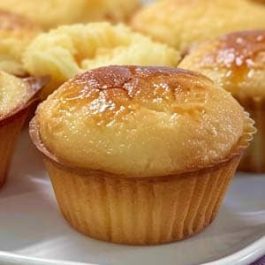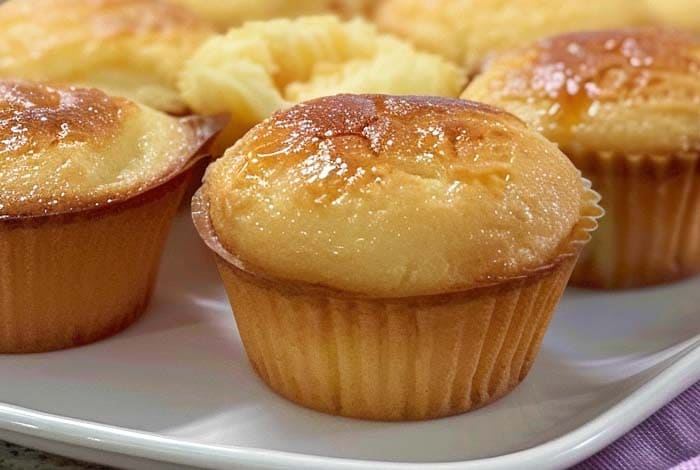Introduction to Chinese Egg Cake
Chinese Egg Cake, or 鸡蛋糕 (jī dàn gāo), is a traditional Chinese dessert that has delighted taste buds for generations. This light, fluffy cake carries with it a rich history and cultural significance, serving as a nostalgic reminder of childhood for many. Unlike its Western counterparts, Chinese Egg Cake is known for its airy texture and subtle sweetness, offering a less dense and more sponge-like experience. Historically, these cakes were steamed, reflecting the cooking methods prevalent in Chinese cuisine, and were often enjoyed during festivals and family gatherings, symbolizing happiness and unity.
The comparison with Western muffins highlights the versatility of egg cakes. While muffins are typically heavier and can be savory or sweet, Chinese Egg Cake focuses on a simple sweetness and a cloud-like texture, making it a unique treat that bridges the gap between a dessert and a light snack.
Why Use a Muffin Tin?
The adaptation of using a muffin tin for baking Chinese Egg Cake is a modern twist that offers several benefits over traditional steaming methods. Firstly, baking in a muffin tin allows for a consistent shape and size, making the cakes not only visually appealing but also conveniently portable. This method also introduces a delightful crust that contrasts beautifully with the soft interior, adding a new dimension to the traditional texture.
When selecting the right muffin tin, consider non-stick varieties for easy removal of the cakes without damaging their delicate structure. Silicone muffin tins are also a great option, as they allow for even heat distribution and flexibility for easier cake release. Ensuring your muffin tin has deep wells can also mimic the traditional tall and fluffy appearance of the cakes.
Essential Ingredients and Substitutes
Basic Ingredients Overview
The beauty of Chinese Egg Cake lies in its simplicity, requiring only a few basic ingredients:
- Eggs: The main ingredient that provides structure and airiness.
- Sugar: Adds sweetness and helps in achieving a light texture.
- Flour: All-purpose flour is commonly used for its gluten content, which gives the cake its body.
- Milk: Adds moisture and enhances the flavor of the cake.
Substitutes and Variations
For those with dietary restrictions or preferences, there are ample substitutes that can be used:
- Gluten-Free Options: Replace all-purpose flour with a gluten-free flour blend. Look for blends that include xanthan gum to mimic the texture and structure provided by gluten.
- Dairy-Free Alternatives: Substitute cow’s milk with almond, soy, or oat milk. These not only make the recipe dairy-free but can also add a subtle nutty or sweet flavor to the cakes.
Experimenting with these substitutes not only makes Chinese Egg Cake more accessible to those with dietary restrictions but also allows for personalization of the recipe to cater to different tastes and preferences.
Step-by-Step Recipe for Chinese Egg Cake in Muffin Tin
Creating the perfect Chinese Egg Cake in a muffin tin involves precision and care, from preparing the ingredients to the final serving. Here’s how to achieve the best results:
Preparation of Ingredients
Start by gathering all your ingredients to ensure a smooth baking process. For this recipe, you will need:
- 4 large eggs, at room temperature
- 1 cup of granulated sugar
- 1 cup of all-purpose flour (or substitute for dietary needs)
- 1/2 cup of milk (dairy or non-dairy alternatives)
- 1/2 teaspoon of baking powder
Bringing eggs to room temperature is crucial as it helps to incorporate more air into the mixture, contributing to the fluffiness of the cake. Similarly, ensure your milk is not too cold to avoid affecting the batter’s temperature.
Mixing Technique for Fluffiness
The secret to the cake’s signature fluffiness lies in the mixing technique:
- Whisk the Eggs and Sugar: In a large bowl, whisk the eggs and sugar together using an electric mixer on high speed until the mixture is pale, thick, and has tripled in volume. This process, known as ribbon stage, can take about 5-8 minutes.
- Sift in the Dry Ingredients: Sift the flour and baking powder together to avoid lumps. Then, gently fold them into the egg mixture using a spatula, making sure not to deflate the air bubbles you’ve worked hard to create.
- Incorporate the Milk: Finally, fold in the milk until just combined, ensuring the batter remains light and airy.
Baking Tips for Perfect Texture
Preheat your oven to 350°F (175°C) before filling your muffin tin:
- Prepare the Muffin Tin: Lightly grease the muffin tin or line it with muffin cups to prevent sticking. If using a silicone muffin tin, you can skip this step.
- Fill the Muffin Cups: Pour the batter into the muffin cups, filling them about three-quarters full to allow space for the cakes to rise.
- Bake to Perfection: Bake for 20-25 minutes, or until the cakes are golden and a toothpick inserted into the center comes out clean. Avoid opening the oven door frequently, as sudden temperature changes can cause the cakes to collapse.
Cooling and Serving Suggestions
Allow the cakes to cool in the tin for about 5 minutes before transferring them to a wire rack to cool completely. This step helps prevent the cakes from becoming soggy.
For serving, these cakes are best enjoyed fresh and warm. However, they can also be served at room temperature. Dust with powdered sugar for a simple yet elegant touch, or pair with fresh fruit for a refreshing contrast. If you’re feeling adventurous, a dollop of whipped cream or a drizzle of honey can elevate these humble cakes into a decadent treat.
Advanced Tips and Tricks for Chinese Egg Cake in Muffin Tin
Troubleshooting Common Issues
Deflation and uneven baking are two common issues that can mar the perfect Chinese Egg Cake. To avoid deflation, ensure that you do not overmix the batter once the flour is added; gentle folding is key to maintaining the airiness. Additionally, avoid opening the oven door frequently during baking, as the sudden temperature change can cause the cakes to collapse. For uneven baking, make sure to rotate the muffin tin halfway through the baking process to ensure even heat distribution. Also, check that your oven is calibrated and heating correctly, as hot spots can lead to uneven baking.
Decoration and Flavor Enhancements
Chinese Egg Cakes in a muffin tin offer a blank canvas for creative decorations and flavor enhancements. For a traditional touch, incorporate flavors like red bean paste, matcha, or sesame into the batter or as a filling. Toppings such as a light dusting of powdered sugar, a drizzle of honey, or a sprinkle of crushed nuts can add texture and depth to the cakes. For special occasions, a dollop of whipped cream and fresh berries can transform these simple cakes into an elegant dessert.
Health and Nutrition Information
A single Chinese Egg Cake is relatively low in calories, making it a suitable option for a light snack or part of a balanced breakfast. The primary ingredients, eggs and milk, provide high-quality protein and essential nutrients. To create healthier variations, consider using whole wheat flour to increase fiber content, or reduce the sugar by substituting part of it with natural sweeteners like stevia. For a dairy-free version, almond or oat milk can be used, which also adds a subtle flavor and additional nutrients.
FAQs
- What makes Chinese egg cake different from other sponge cakes? Chinese Egg Cake is known for its exceptionally light and airy texture, achieved through the vigorous whisking of eggs and sugar. Unlike other sponge cakes that might rely on butter or oil, Chinese Egg Cake traditionally uses minimal fat, resulting in a delicate crumb.
- Can I make these cakes vegan? Yes, to make vegan Chinese Egg Cakes, substitute eggs with a mixture of flaxseed or chia seeds and water. Use dairy-free milk alternatives and ensure that the sugar is vegan-friendly. Note that the texture might be slightly denser than the traditional version.
- How do I store leftover cakes to maintain freshness? Store leftover Chinese Egg Cakes in an airtight container at room temperature for up to 2 days. For longer storage, refrigerate them for up to a week. To revive the cakes, a quick warm-up in the microwave can help restore their soft texture.

Chinese Egg Cake in Muffin Tin Recipe
Equipment
- Muffin tin
- Electric mixer
- Mixing bowls
- Sifter
- Spatula
- Wire rack
Ingredients
- 4 large eggs at room temperature
- 1 cup granulated sugar
- 1 cup all-purpose flour or gluten-free alternative
- 1/2 teaspoon baking powder
- 1/2 cup milk dairy or non-dairy alternative
Instructions
- Preheat the Oven: Start by preheating your oven to 350°F (175°C) and prepare your muffin tin by greasing it or lining it with muffin cups.
- Whisk Eggs and Sugar: In a large bowl, use an electric mixer to whisk the eggs and sugar together until pale, thick, and tripled in volume.
- Fold in Dry Ingredients: Sift the flour and baking powder together, then gently fold them into the egg mixture, being careful not to deflate the batter.
- Add Milk: Gently fold in the milk until just combined, ensuring the batter remains light.
- Bake: Pour the batter into the prepared muffin cups, filling each about three-quarters full. Bake for 20-25 minutes, or until golden and a toothpick inserted comes out clean.
- Cool and Serve: Allow the cakes to cool in the tin for 5 minutes before transferring to a wire rack to cool completely. Serve warm or at room temperature.
Notes
- Substitutions: For a gluten-free version, use a gluten-free flour blend that includes xanthan gum. For dairy-free cakes, any plant-based milk like almond or oat milk can be used.
- Storage: Store in an airtight container at room temperature for up to 2 days or refrigerate for up to a week. Warm briefly in the microwave before serving if desired.
- Customizations: Feel free to add traditional Chinese flavors such as red bean paste or matcha powder to the batter, or top with fresh fruit, whipped cream, or a sprinkle of powdered sugar for extra sweetness and texture.

